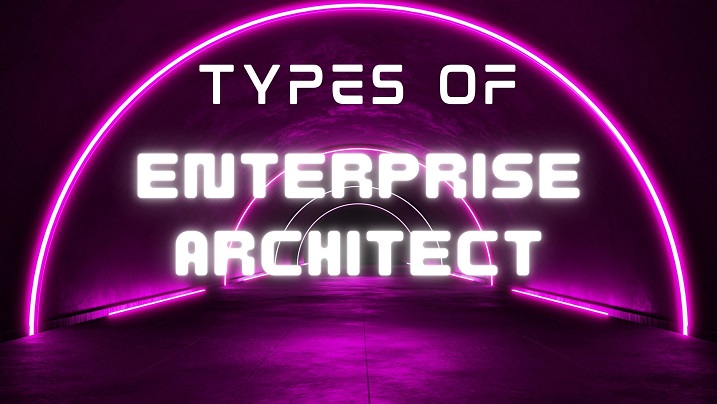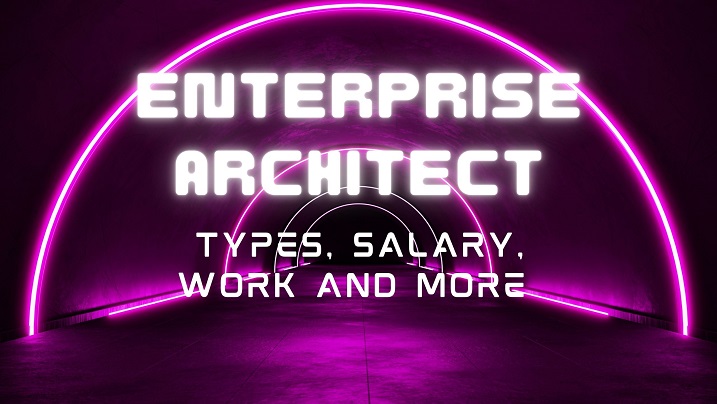Enterprise Architect – Types, Salary, Work and More in 2024
Hello friends, today we will know about Cloud Enterprise Architect.
What is Enterprise Architect?
Enterprise Architects are responsible for designing and implementing enterprise-wide technology solutions and strategies that align with an organization’s business goals and objectives. They work closely with business leaders, stakeholders, and IT teams to create a roadmap for technology transformation that optimizes business processes, increases efficiency, reduces costs, and improves customer satisfaction.
Some of the key responsibilities of an Enterprise Architect include:
Assessing business needs: Enterprise Architects must have a deep understanding of the organization’s business operations, goals, and objectives to identify areas for improvement and recommend solutions.
Developing technology strategies: They must create a technology roadmap that aligns with the organization’s overall business strategy and supports its goals and objectives.
Collaborating with stakeholders: Enterprise Architects must work closely with business leaders, stakeholders, and IT teams to understand their needs and requirements and ensure that the technology solutions meet their needs.
Leading architecture design: They must design the overall technology architecture, including hardware, software, networks, and security systems, that supports the organization’s business needs.
Managing technology projects: Enterprise Architects oversee the implementation of technology projects, ensuring that they are completed on time, within budget, and meet the organization’s requirements.
Managing technology risks: They must identify and manage technology risks, including cybersecurity threats, compliance issues, and other risks that could impact the organization’s operations.
Monitoring technology performance: Enterprise Architects must monitor the performance of technology solutions to ensure that they are meeting the organization’s requirements and goals.
Ensuring compliance: They must ensure that technology solutions comply with relevant laws, regulations, and industry standards.
Managing vendor relationships: Enterprise Architects must manage relationships with technology vendors and service providers to ensure that they are delivering high-quality solutions and services.
Providing guidance and support: They must provide guidance and support to IT teams and other stakeholders, including training, mentoring, and coaching.
To become an Enterprise Architect, individuals typically need a bachelor’s or master’s degree in computer science, information technology, or a related field.
They must have extensive experience in IT and technology architecture and may hold certifications such as TOGAF (The Open Group Architecture Framework) or Zachman Framework. Excellent communication, collaboration, and leadership skills are also essential.
How to Become a Railroad Worker

Types of Enterprise Architects
There are several types of Enterprise Architects, including:
Business Architect: They focus on aligning business goals, objectives, and strategies with IT infrastructure.
Data Architect: They design and implement data architecture and data management strategies, including data modeling, metadata management, and data governance.
Application Architect: They design and develop software applications that meet the needs of the organization.
Infrastructure Architect: They design and oversee the implementation of the organization’s IT infrastructure, including hardware, software, and networks.
Security Architect: They ensure the security of the organization’s IT systems and data by designing and implementing security controls and policies.
Technology Architect: They evaluate new and emerging technologies and recommend the adoption of technologies that will improve the organization’s efficiency and effectiveness.
Solution Architect: They work with project teams to design and implement IT solutions that meet the needs of the organization.
Integration Architect: They design and implement systems that integrate different IT systems and applications within an organization.
Process Architects: They design and implement business processes and workflows that are efficient, effective, and aligned with the organization’s goals and objectives.
Enterprise Architect: They work at the strategic level to align the organization’s IT strategy with its overall business strategy, ensuring that IT systems and infrastructure support the organization’s goals and objectives.
How to become an Enterprise Architect?
To become an Enterprise Architect, the following steps are generally recommended:
Earn a bachelor’s degree in a relevant field: Enterprise Architects usually have a degree in computer science, information technology, or a related field. However, some employers may accept candidates with degrees in business, engineering, or a related field.
Gain work experience: Most employers prefer Enterprise Architects with several years of experience in IT or a related field. Candidates can gain experience working in roles such as software developer, systems analyst, or IT project manager.
Earn a certification: There are several certifications that Enterprise Architects can earn to demonstrate their expertise and knowledge. Some popular certifications include TOGAF, AWS Certified Solutions Architect, Microsoft Certified: Azure Solutions Architect, and Google Cloud Certified – Professional Cloud Architect.
Develop technical and soft skills: Enterprise Architects need a range of technical skills, including experience with software development, network infrastructure, and databases. They also need strong communication, leadership, and problem-solving skills.
Stay up-to-date with new technologies and trends: Enterprise Architects need to stay informed about new and emerging technologies, as well as trends in their industry. They can do this by attending conferences, reading industry publications, and participating in professional organizations.
Consider an advanced degree: Some employers prefer candidates with a master’s degree in IT, business, or a related field. However, an advanced degree is not always required.
Apply for Enterprise Architect positions: Once candidates have the required education, experience, and certifications, they can begin applying for Enterprise Architect positions. They should tailor their resumes and cover letters to each job application, highlighting their relevant skills and experience.
What is the salary of an Enterprise Architect in India?
The salary of an Enterprise Architect in India can vary depending on several factors such as experience, location, company size, and industry.
According to data from Payscale, the average salary for an Enterprise Architect in India is around ₹2,787,000 per year. However, salaries can range from ₹1,196,000 to ₹4,911,000 per year depending on the factors mentioned above.
What is the salary of an Enterprise Architect in Foreign Countries?
The salary of an Enterprise Architect in foreign countries can vary depending on several factors such as location, company size, industry, and experience.
According to data from Glassdoor, the average salary for an Enterprise Architect in the United States is around $144,000 per year, while in the United Kingdom, it is around £87,000 per year.
In Canada, the average salary for an Enterprise Architect is around C$135,000 per year, while in Australia, it is around AU$ 157,000 per year.
It is important to note that salaries can vary depending on the company and industry, and some positions may offer additional benefits and bonuses.
How to Become a Water Transportation Worker
10 responsibilities of Enterprise Architect
Here are 10 common responsibilities of an Enterprise Architect:
- Developing and maintaining the company’s overall IT strategy and technology roadmap.
- Collaborating with business and technology stakeholders to define the company’s business processes and requirements.
- Designing, developing, and maintaining the company’s enterprise architecture framework, principles, and standards.
- Conducting architecture assessments to identify gaps and opportunities for improvement.
- Creating solution architecture designs that align with the company’s technology roadmap and business strategy.
- Providing technical guidance and leadership to development teams and project managers.
- Facilitating communication between business and technology teams to ensure alignment on project goals and objectives.
- Assessing emerging technologies and industry trends to identify opportunities to improve the company’s IT capabilities.
- Developing and managing enterprise architecture governance processes to ensure compliance with policies and standards.
- Creating and delivering architecture training and educational materials for IT and business stakeholders to ensure a common understanding of the company’s IT strategy and architecture.
Enterprise Architect Specialist
An Enterprise Architect Specialist is an expert in the field of enterprise architecture who has advanced knowledge and skills in designing and implementing complex enterprise-wide systems.
They possess extensive experience in defining enterprise architecture strategies, frameworks, and roadmaps that align with business goals and objectives.
Some key responsibilities of an Enterprise Architect Specialist include:
- Leading the development and implementation of enterprise architecture strategies and roadmaps.
- Collaborating with business and technology stakeholders to identify and prioritize business and technical requirements.
- Defining enterprise-wide technology standards, policies, and best practices.
- Providing technical leadership and guidance to development teams and project managers.
- Conducting architecture assessments to identify gaps and opportunities for improvement.
- Designing and implementing complex enterprise-wide systems that align with the company’s technology roadmap and business strategy.
- Developing and managing enterprise architecture governance processes to ensure compliance with policies and standards.
- Assessing emerging technologies and industry trends to identify opportunities to improve the company’s IT capabilities.
- Creating and delivering architecture training and educational materials for IT and business stakeholders to ensure a common understanding of the company’s IT strategy and architecture.
- Staying up-to-date with new and emerging enterprise architecture technologies, trends, and best practices.

FAQ
What does an enterprise architect do?
An enterprise architect is responsible for designing and maintaining an organization’s IT architecture to align with its business goals and objectives.
They are responsible for overseeing the development and implementation of IT solutions to ensure that they are efficient, secure, and cost-effective. Some of the specific tasks that an enterprise architect might perform include:
Assessing current IT infrastructure: The enterprise architect will evaluate the organization’s current IT infrastructure, including hardware, software, and network systems, to identify strengths and weaknesses.
Developing an enterprise architecture framework: The enterprise architect will develop a framework that outlines how IT solutions should be designed, implemented, and managed to meet business goals and objectives.
Collaborating with stakeholders: The enterprise architect will work closely with stakeholders from different departments and levels within the organization to understand their needs and ensure that IT solutions are aligned with their goals.
Designing IT solutions: The enterprise architect will design IT solutions that align with the enterprise architecture framework and meet the needs of stakeholders.
Implementing IT solutions: The enterprise architect will oversee the implementation of IT solutions, ensuring that they are implemented efficiently and effectively.
Monitoring and maintaining IT solutions: The enterprise architect will monitor the performance of IT solutions and make adjustments as necessary to ensure they continue to meet the needs of the organization.
Overall, the enterprise architect plays a critical role in ensuring that an organization’s IT solutions align with its business goals and objectives.
They must have a deep understanding of both business and technology and be able to collaborate effectively with stakeholders from different areas of the organization.
How to Become a Computer Support Specialist
How can I become an enterprise architect?
To become an enterprise architect, you typically need a combination of education, experience, and technical skills. Here are some steps you can take to become an enterprise architect:
Obtain a relevant degree: A bachelor’s or master’s degree in computer science, information technology, or a related field can provide a strong foundation for a career in enterprise architecture.
Gain work experience: To become an enterprise architect, you typically need several years of experience working in IT roles such as systems analyst, software engineer, or project manager. This experience can help you develop the technical skills and knowledge necessary for a career in enterprise architecture.
Develop technical skills: Enterprise architects need to have a deep understanding of technology, including hardware, software, and network systems. You can gain technical skills through certifications, training programs, and on-the-job experience.
Learn about enterprise architecture frameworks: Familiarize yourself with enterprise architecture frameworks such as TOGAF, Zachman, or FEAF.
These frameworks provide a structured approach to enterprise architecture and can help you develop the skills and knowledge necessary to become an enterprise architect.
Obtain enterprise architecture certifications: Many organizations offer certifications for enterprise architects, such as the TOGAF certification. These certifications can demonstrate your expertise in enterprise architecture and help you stand out in the job market.
Build your network: Networking with other enterprise architects and IT professionals can help you learn about job opportunities and stay up-to-date with the latest trends in enterprise architecture.
Overall, becoming an enterprise architect requires a combination of education, experience, technical skills, and a strong understanding of business and technology. With the right preparation and dedication, you can build a successful career as an enterprise architect.
Is enterprise architect a good position?
Yes, an enterprise architect is generally considered a good position. Enterprise architects play a crucial role in helping organizations align their business goals and technology infrastructure, and in ensuring that their IT systems are efficient, effective, and secure. As a result, enterprise architects are typically highly valued and well-compensated professionals.
In addition to offering a rewarding and challenging career path, enterprise architecture can also provide opportunities for growth and advancement.
Enterprise architects may be able to advance to senior leadership positions within their organizations or may be able to pursue opportunities in consulting or other areas of IT.
However, like any job, the experience of working as an enterprise architect can vary depending on the organization and industry in which you work.
Some organizations may have a more strategic focus for their enterprise architects, while others may have a more technical focus.
It’s important to research potential employers and understand the specific responsibilities and expectations of the enterprise architect role before pursuing this career path.
Does enterprise architecture require coding?
Enterprise architecture typically does not require coding in the traditional sense. While enterprise architects need to have a strong understanding of technology and be able to work with technical teams, they are generally responsible for developing high-level strategies and frameworks for the organization’s IT infrastructure rather than writing code.
That being said, having some programming experience or knowledge can be helpful for enterprise architects.
Understanding programming languages and development methodologies can help enterprise architects work more effectively with technical teams and communicate technical requirements more clearly.
Additionally, enterprise architects may need to review and understand code as part of their work, even if they are not writing it themselves.
Overall, while coding skills are not necessarily required for enterprise architects, having some technical knowledge and experience can be beneficial for success in this role.
Is enterprise architect technical?
Yes, enterprise architects are typically technical professionals. Enterprise architects need to have a strong understanding of technology and be able to work with technical teams to develop and implement strategies for the organization’s IT infrastructure.
They need to understand the organization’s technology needs, identify gaps in the current infrastructure, and develop plans to address those gaps.
They also need to be able to evaluate new technologies and assess their potential impact on the organization.
That being said, enterprise architects also need to have strong communication and collaboration skills.
They must be able to work with stakeholders across the organization, including business leaders, technical teams, and other key players.
They need to be able to translate technical concepts into language that non-technical stakeholders can understand, and they need to be able to work with diverse teams to implement complex IT projects.
Overall, enterprise architects need to be both technical and strategic, with the ability to understand the organization’s technology needs and develop plans to meet those needs while also working effectively with stakeholders across the organization.
Can a fresher become an Enterprise Architect?
It is highly unlikely for a fresher to become an Enterprise Architect directly. Enterprise Architects typically require a significant amount of experience and expertise in the technology domain, along with a deep understanding of the organization’s business processes, goals, and strategies.
Typically, professionals who become enterprise architects have a solid foundation in IT, software engineering, or related fields and have worked in various technical roles for several years.
They may have experience in software development, systems administration, data analysis, or other technical areas, as well as experience in project management, business analysis, or other related areas.
However, a fresher can start by building their technical skills, gaining experience in various IT roles, and developing a deep understanding of the technology domain.
They can also consider pursuing relevant certifications, such as those offered by TOGAF or other professional organizations, which can help demonstrate their knowledge and expertise in enterprise architecture. As they gain experience and expertise, they can work towards becoming an enterprise architect in the future.
Is Enterprise Architect a senior role?
Yes, Enterprise Architect is typically a senior-level role within an organization. Enterprise architects are responsible for developing and implementing strategies for the organization’s IT infrastructure, and they work closely with senior executives, including CIOs and other members of the executive team.
They must have a deep understanding of the organization’s business processes, goals, and strategies, as well as a strong technical background in IT and software engineering.
Enterprise architects typically have several years of experience in various technical roles and have demonstrated strong leadership, communication, and problem-solving skills.
They are responsible for overseeing complex IT projects and ensuring that they align with the organization’s overall business objectives.
Overall, the role of Enterprise Architect is a critical one within an organization, and it requires a high level of experience, expertise, and leadership skills.
Is enterprise architecture a stressful job?
Like any high-level job, Enterprise Architect can be stressful at times. Enterprise architects are responsible for developing and implementing IT strategies that align with an organization’s overall business objectives.
They must work closely with senior executives, as well as other IT professionals, to ensure that the organization’s IT infrastructure is effective and efficient.
To be successful in this role, Enterprise Architects must have a deep understanding of both the organization’s business processes and IT infrastructure.
They must be able to manage complex projects, communicate effectively with stakeholders, and solve problems quickly and efficiently. This requires a great deal of expertise, experience, and attention to detail, which can be stressful.
However, the level of stress can vary depending on the organization, the industry, and the individual.
Some Enterprise Architects may find that the role is highly rewarding, while others may struggle with the demands of the job.
Ultimately, the level of stress will depend on the individual’s ability to manage the demands of the role, as well as their work style and preferences.
How to Become a Computer Hardware Engineer
What is the next level of enterprise architecture? | What is next after enterprise architect?
The next level for an Enterprise Architect typically involves taking on a more senior or executive role within an organization.
This may include positions such as Chief Information Officer (CIO), Chief Technology Officer (CTO), or Chief Digital Officer (CDO).
These roles typically involve more strategic decision-making and broader responsibilities for the organization’s overall technology strategy.
In addition, Enterprise Architects may also choose to specialize in a particular area of technology, such as cloud computing, data analytics, or cybersecurity.
They may also pursue additional certifications or education in areas such as project management, business strategy, or leadership, to enhance their skills and advance their careers.
Overall, the path for an Enterprise Architect will depend on their personal career goals and the needs of the organizations they work for.
The role of Enterprise Architect is a highly specialized and sought-after position, and those who excel in this field will have a wide range of opportunities for advancement and career growth.
Are enterprise architects in demand?
Yes, Enterprise Architects are in high demand, as organizations increasingly recognize the importance of effective IT management and technology-driven innovation to their success.
As businesses grow and become more complex, the need for a strategic IT architecture becomes even more critical. Enterprise Architects play a key role in developing and implementing effective IT strategies that align with the overall business goals of an organization.
According to the U.S. Bureau of Labor Statistics, employment of computer and information systems managers, which includes Enterprise Architects, is projected to grow 10 percent from 2021 to 2031, which is faster than the average for all occupations.
This growth is driven by the increasing reliance on technology across industries, as well as the need for organizations to manage and secure their IT infrastructure effectively.
In addition, Enterprise Architects are in demand because of their specialized skills and expertise, which are difficult to find in the general IT job market.
The demand for Enterprise Architects is expected to remain strong in the coming years as organizations continue to invest in digital transformation and innovative technology solutions.
Who uses enterprise architect?
Enterprise Architect is used by a wide range of organizations across various industries, including:
Government agencies: Many government agencies use Enterprise Architects to design and manage their IT infrastructure and systems.
Financial services: Banks, insurance companies, and other financial services companies use Enterprise Architects to design and manage their IT systems and applications.
Healthcare: Healthcare organizations use Enterprise Architect to design and manage electronic health records (EHR) systems, medical imaging systems, and other healthcare IT solutions.
Manufacturing: Manufacturers use Enterprise Architect to design and manage their supply chain systems, product lifecycle management systems, and other manufacturing IT solutions.
Retail: Retailers use Enterprise Architect to design and manage their e-commerce systems, inventory management systems, and other retail IT solutions.
Technology: Technology companies use Enterprise Architects to design and manage their software applications, cloud-based services, and other technology solutions.
In summary, any organization that requires complex IT infrastructure and needs to manage its technology assets effectively can benefit from using Enterprise Architect.
Can software engineers become enterprise architect?
Yes, a software engineer can become an enterprise architect, but it typically requires additional skills and experience beyond those typically gained in a software engineering role.
Enterprise architecture involves a broad range of skills, including technical, business, and leadership skills. To become an enterprise architect, a software engineer would need to develop expertise in these areas.
Some steps that a software engineer can take to become an enterprise architect include:
Gain experience in software development: Software engineers should have a strong foundation in software development and gain experience working with a variety of software technologies.
Develop business skills: Enterprise architects need to have a good understanding of business processes, financial management, and project management.
Develop leadership skills: Enterprise architects need to be able to lead teams and communicate effectively with stakeholders at all levels of the organization.
Obtain relevant certifications: Certifications such as TOGAF (The Open Group Architecture Framework) or Zachman Framework can help software engineers gain the knowledge and skills needed to become an enterprise architects.
Pursue advanced education: Many enterprise architects have advanced degrees, such as an MBA or a master’s degree in information technology or computer science.
Becoming an enterprise architect can be a challenging and rewarding career path for software engineers who are interested in taking on a more strategic role in the organization.
Are enterprise architects happy?
Like any profession, the level of happiness among enterprise architects can vary depending on several factors such as company culture, job satisfaction, work-life balance, and compensation.
However, many enterprise architects find their work to be rewarding and enjoy the challenge of working on complex projects that require both technical and business skills.
Enterprise architects who can align their work with their personal goals and interests, and who feel valued by their organization, are more likely to report high levels of job satisfaction and overall happiness in their careers.
It’s important to note that like any job, being an enterprise architect can also come with its own set of challenges and stressors.
The role requires a high level of responsibility and attention to detail and can involve working long hours or dealing with difficult stakeholders.
Overall, the happiness of an enterprise architect will depend on several individual factors, but with the right combination of skills, experience, and personal goals, many enterprise architects find the role to be challenging, rewarding and fulfilling.
How much money does an enterprise architect?
The salary of an enterprise architect can vary greatly depending on several factors such as location, industry, experience, and company size.
In general, enterprise architects are highly skilled professionals and typically earn a higher salary than many other IT roles.
According to data from Glassdoor, the average base salary for an enterprise architect in the United States is around $142,000 per year, with salaries ranging from $106,000 to $193,000 depending on location and experience.
However, some enterprise architects at larger companies or in more specialized industries can earn even higher salaries.
It’s important to note that compensation for an enterprise architect often includes not just a base salary, but also bonuses, stock options, and other benefits such as retirement plans and health insurance.
Additionally, as with any profession, salaries can vary widely based on individual factors, so it’s important to research compensation in your specific area and industry to get a more accurate idea of potential earnings.
What field is Enterprise Architecture?
Enterprise Architecture is a field within Information Technology (IT) that focuses on designing and managing the overall structure and organization of an enterprise’s IT systems and processes.
It involves creating and maintaining an overall blueprint or framework for the enterprise’s technology architecture that aligns with the organization’s strategic goals and objectives.
Enterprise Architecture typically involves a range of activities, including planning and analysis, systems design, integration, and governance.
It is a critical function for large and complex organizations that rely heavily on technology to support their business operations and strategies.
Does Google have enterprise architects?
Yes, Google has Enterprise Architects who are responsible for designing and implementing the overall structure and organization of the company’s IT systems and processes.
They work closely with product teams, engineering teams, and other stakeholders to ensure that the company’s technology architecture is aligned with its strategic goals and objectives.
Google’s Enterprise Architects are highly skilled professionals with expertise in a range of areas, including software development, infrastructure design, data management, security, and compliance.
They play a critical role in enabling Google to deliver innovative products and services that meet the needs of its customers and users.
Are architects highly intelligent?
Intelligence is a complex and multifaceted trait, and it’s difficult to make blanket statements about any group of professionals.
Architects are highly trained and skilled professionals who require a broad range of knowledge and expertise in areas such as design, engineering, project management, and construction.
They must be able to think critically, solve complex problems, and communicate effectively with clients and other stakeholders.
Architects also need to be creative and innovative, able to envision new possibilities and translate them into tangible designs.
However, like any profession, the level of intelligence among architects can vary depending on individual factors such as education, experience, and natural abilities.
What is the life of an enterprise architect?
The life of an enterprise architect can vary depending on the organization and industry in which they work. However, there are some common aspects of the job that most enterprise architects can expect to encounter:
Planning and strategizing: Enterprise architects spend a significant amount of time planning and strategizing the overall architecture of an organization. They work to align technology with business goals and objectives and ensure that technology solutions are scalable, flexible, and efficient.
Collaboration: Enterprise architects work with a range of stakeholders, including IT teams, business leaders, and third-party vendors, to ensure that technology solutions are meeting the needs of the organization.
Technical analysis: Enterprise architects must have a deep understanding of a range of technologies and be able to analyze technical solutions to determine their feasibility and effectiveness.
Communication: Enterprise architects must be able to communicate complex technical concepts to a range of stakeholders clearly and concisely.
Continuous learning: Enterprise architects must stay up-to-date with the latest technologies and trends in their field to ensure that they are providing the best solutions for their organization.
Overall, the life of an enterprise architect can be challenging but also rewarding, as they can make a significant impact on the overall technology strategy and direction of an organization.
What is the difference between a software architect and an enterprise architect?
The main difference between a software architect and an enterprise architect is the scope of their work.
A software architect focuses on the design and structure of software systems and applications. They are responsible for creating software solutions that meet the requirements of a specific project or product.
Software architects work closely with development teams to ensure that the software is well-designed, maintainable, scalable, and efficient. They also ensure that the software meets the business and technical requirements of the organization.
On the other hand, an enterprise architect focuses on the overall IT strategy and architecture of an organization. They are responsible for creating and maintaining a comprehensive and integrated view of the organization’s technology systems, including software, hardware, and networks.
They work with business leaders and IT professionals to identify opportunities for innovation and improvement and develop solutions that support the organization’s business goals.
Enterprise architects also ensure that the IT systems align with the organization’s overall strategy and goals and that they are efficient, secure, and scalable.
Can architects join NASA?
Yes, architects can join NASA depending on their qualifications and experience. NASA hires a wide range of professionals, including architects, to work on various projects related to space exploration, research, and technology development.
However, the specific requirements and qualifications for each position may vary, so it is important to check the job listings on the NASA website to determine the eligibility criteria for any given role.
What is the difference between an enterprise architect and a technical architect?
Enterprise architecture and technical architecture are related but distinct disciplines within the field of architecture. While there is some overlap in their responsibilities, there are also some key differences.
Enterprise architecture is concerned with the overall structure and alignment of an organization’s business and IT capabilities.
The focus is on designing and maintaining an integrated and coherent set of systems and processes that support the organization’s goals and objectives.
Enterprise architects are responsible for developing and maintaining the enterprise architecture framework, ensuring that it is aligned with the business strategy, and managing the enterprise architecture function within the organization.
Technical architecture, on the other hand, is more focused on the design and implementation of specific technical solutions within an organization.
Technical architects are responsible for defining the technical architecture and infrastructure that support the organization’s systems and applications.
This includes selecting and configuring hardware and software components, defining data models and schemas, and ensuring that the technical environment is secure, reliable, and scalable.
In summary, enterprise architects have a broader, strategic focus, while technical architects are more focused on the details of technical implementation.
Enterprise architects work at a higher level within the organization, while technical architects work more closely with developers and other technical staff.
Investment Banker | Chartered Accountant | IT Manager | Dentist | Software Architect | Orthodontist | Data Scientist | Psychiatrist | Physician | Surgeon | Cloud Engineer | Full Stack Developer | Sales Director | Corporate Lawyer | Blockchain Developer | Marketing Manager | Petroleum Engineer
What are the four types of enterprise architecture?
The four types of enterprise architecture are:
Business Architecture: This type of architecture focuses on the business processes, functions, and goals of the organization. It provides a high-level view of the organization’s structure, capabilities, and operating model.
Data Architecture: This type of architecture deals with the organization’s data assets, including databases, data flows, and data storage. It provides a blueprint for organizing and managing data assets across the organization.
Application Architecture: This type of architecture focuses on the organization’s software applications, including their functionality, interactions, and interfaces. It provides a blueprint for designing and deploying software applications that meet business requirements.
Technology Architecture: This type of architecture deals with the organization’s technology infrastructure, including hardware, networks, and systems.
It provides a blueprint for designing and implementing the technology infrastructure needed to support the organization’s business processes and applications.
What is an example of enterprise architecture?
An example of enterprise architecture could be the development of a new customer relationship management (CRM) system for a company.
The enterprise architect would work to define the company’s overall goals and objectives, analyze the current state of the company’s business processes, data, and technology infrastructure, and create a roadmap for the new CRM system’s development and integration with existing systems.
This would involve assessing the company’s current customer data management practices, determining the required functionalities for the new CRM system, selecting appropriate technology platforms, defining data models, creating standards and guidelines for data management, and ensuring the system integrates with other enterprise systems such as accounting and marketing.
The enterprise architect would also ensure that the CRM system aligns with the company’s overall business strategy and objectives and that it can scale and adapt to future changes and growth.
What are the 6 basic elements of enterprise architecture?
Enterprise architecture typically includes six basic elements:
Business architecture: Describes the organization’s structure, processes, capabilities, and business goals.
Data architecture: Defines the organization’s data strategy, data models, and data management processes.
Application architecture: Describes the organization’s software applications, their interactions, and their alignment with the business goals.
Technology architecture: Defines the organization’s technology infrastructure, including hardware, software, networks, and security.
Security architecture: Defines the organization’s security strategy, policies, and procedures to protect against cyber threats.
Infrastructure architecture: Defines the physical and logical infrastructure that supports the organization’s technology infrastructure and business operations.
These six elements work together to create a comprehensive view of an organization’s current state and a roadmap for achieving its future goals.
What are the 5 five components of enterprise?
The five components of an enterprise, according to the Zachman Framework, are:
- Data: The information that is used and managed by the enterprise.
- Processes: The activities or tasks that are performed to create value for the enterprise.
- Locations: The physical places where the enterprise operates, including buildings, facilities, and data centers.
- People: The roles, responsibilities, and skills of the individuals who work for the enterprise.
- Technologies: The hardware, software, and other tools that are used to support the enterprise’s operations.
These five components are interrelated and need to be considered together to develop a comprehensive enterprise architecture.





